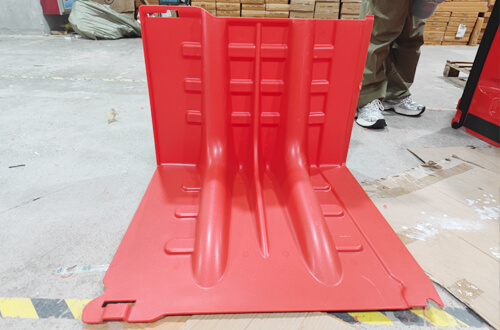
There are significant differences between aluminum and ABS flood barriers in terms of material, performance, installation methods and application areas.
Material and corrosion resistance
Aluminum alloy flood barrier is mainly made of aluminum profiles with anodized surface, which has good corrosion and oxidation resistance. This material is not only able to resist salt and chemical erosion in flood water, but also suitable for various environmental conditions.
The material is suitable for a wide range of environmental conditions. In addition, aluminum is lightweight and strong, making it easy to transport and install.
In contrast, ABS flood barrier are made from composite materials such as polystyrene (PS) and acrylonitrile (AN), which are water and impact resistant, but not as corrosion and aging resistant as aluminum alloys. ABS flood protection panels are typically used for temporary protection, such as in underground garages, subway entrances and exits, and other places.
Performance and Structure
Aluminum alloy flood barrier have excellent waterproof sealing effect, which can effectively prevent flood water from intruding into the room and causing property damage. Its structural design includes side columns, center columns, and auxiliary accessories such as expansion screws and wall hangers to ensure the stability and sealing of the overall structure. In addition, the aluminum flood panels can be quickly disassembled and stacked for storage, making them suitable for backup equipment.
ABS flood barrier are also waterproof and can increase stability by converting water pressure into friction through the “L-shaped bookend principle”. However, their structure is relatively simple, mostly in the form of straight or internally curved panels, and they are mainly used for temporary raising of embankments and underpasses.
Installation
The installation process of aluminum alloy flood protection panels is relatively complicated, which requires pre-preparation of installation tools, measurement of horizontal and vertical degrees, installation of pre-embedded parts, ground rails, side columns, corner columns, center columns and diagonal support and other steps. This complicated installation makes the aluminum alloy flood protection plate more suitable for long-term fixed use.
Aluminum Alloy Flood Panels are more suitable for long-term fixed use.
ABS flood panels are much easier to install and disassemble, and are usually a one-piece molded design that can be quickly assembled and moved by handles or latches. This ease of use makes them more suitable for sudden flooding situations.
申し込み
Aluminum flood control panel are widely used in areas such as urban hard embankments, underground garages, subway entrances and important buildings due to their durability and high protection. It is suitable for long-term flood protection needs and high-risk areas.
ABS Flood barrier is suitable for long-term flood protection needs and high-risk areas.
ABS flood control panels are more often used for temporary flood protection measures, such as emergency flood protection in residential neighborhoods, schools, hospitals and other places due to their lightweight and easy-to-install characteristics.
Overall, aluminum alloy flood panels are superior to ABS flood panels in terms of corrosion resistance, structural strength, and applicability, making them suitable for long-term fixed use, while ABS flood panels are more suitable for dealing with short-term or temporary flood protection needs due to their lightweight and easy-to-install characteristics. The choice of which type of flood protection board should be based on specific application scenarios and needs.

気候変動や異常気象がますます深刻化する中で、都市の能力は、そのような気候変動や異常気象に対処するために必要不可欠なものとなっている。

素材と構造 1.優れた素材:一般的にABSプラスチックから構成され、この材料は、...

地球温暖化によって異常気象が増加し、大雨による洪水や洪水...

アルミ製洪水障壁 通常、押出成形により6063アルミニウム合金(側柱を含む)で作られる。 D...

なぜ質の交通ガードレールのハイウェーのガードレールはハイウェーの安全のために重大であるか。 1.安全性の向上